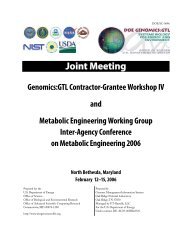2005 gtl abstracts.indb - Genomics - U.S. Department of Energy
2005 gtl abstracts.indb - Genomics - U.S. Department of Energy
2005 gtl abstracts.indb - Genomics - U.S. Department of Energy
You also want an ePaper? Increase the reach of your titles
YUMPU automatically turns print PDFs into web optimized ePapers that Google loves.
<strong>Genomics</strong>:GTL Program Projects<br />
a Hyperspectral Imaging instrument. Each <strong>of</strong> the institutes has an independent system for keeping<br />
track <strong>of</strong> metadata about their part <strong>of</strong> the operation and unfortunately these systems do not facilitate<br />
easy transfer <strong>of</strong> metadata details between institutions. This situation is typical <strong>of</strong> many biology projects,<br />
and it begs for a solution.<br />
In this sub-project we set out to develop a single system where such metadata can be collected and<br />
linked in an orderly fashion. We developed a web-based Data Entry and Browsing (DEB) tool<br />
that can capture the metadata from experiments and laboratories and store them in a database in a<br />
computer searchable form. The key need is to have an easy-to-use intuitive system that integrates the<br />
metadata <strong>of</strong> all the related activities in this project. The design <strong>of</strong> the DEB tool is based on inputs<br />
and insights from the biologists on the project and as such contains features that a biologist will find<br />
useful. The interface design mimics the familiar laboratory notebook format. The system is built on<br />
top <strong>of</strong> the Oracle database system. The main concept <strong>of</strong> the interface design is to expose the biologist<br />
to a single “object” and its attributes at a time, and presenting objects as pages in a notebook that can<br />
be “turned”, yet provide links between the objects in a simple intuitive fashion. An example <strong>of</strong> such a<br />
web-based screen is shown in the figure below.<br />
The most powerful capability <strong>of</strong> the DEB system is that it is schema-driven, that is, all the interfaces<br />
to support all <strong>of</strong> the above features are generated automatically from the schema definition. Therefore,<br />
new metadata schemas can quickly be used to generate DEB interfaces as well as the underlying<br />
Oracle database for them. This feature makes this tool immediately applicable to new and/or changing<br />
databases. This allowed us to generate databases based on schemas designed by the biologists.<br />
Specifically, the scientists from the three sites have defined schemas for the Nucleotide Pool <strong>of</strong><br />
microbes, for the Microarray Hybridization (based on the MIAME concepts), and the Hyperspectral<br />
Imaging and analysis system. The design included the ability to link these schemas and thus allow<br />
a researcher from any area <strong>of</strong> the project to extract metadata from the various parts <strong>of</strong> the experiment.<br />
For example the microarray hybridization schema has “probe_source” that links (points to) the<br />
“nucleotide_pool_id” in the Nucleotide Pool schema.<br />
Data entry to the databases is done in two different modes: 1) on-line web-based data entry, and 2)<br />
automated data uploading from another database source. The on-line mode is used by the people<br />
who culture the Nucleotide Pools (Scripps), and the people running the Hyperspectral Imaging<br />
(Sandia). The automated data uploading is used for the Microarray Hybridization metadata (TIGR)<br />
because they have their own well-developed internal database system. The automated metadata<br />
loading is performed by dumping the metadata into simple formatted files (similar the spreadsheet<br />
output format) and have schema-driven tools for loading the data into the common database.<br />
The main features <strong>of</strong> the DEB system are:<br />
26 * Presenting author<br />
•<br />
•<br />
•<br />
•<br />
It supports multiple inter-related object-classes, such as “experiment, materials, nucleotidepool,<br />
samples, arrays, etc.<br />
For each object-class, it displays a page that mimics a notebook, with pages that can be<br />
“turned” (i.e. selected by previous-next, or by number)<br />
Objects can be linked to each other by simple connectors, such as a “sample” object linked to<br />
its “nucleotide-pool”.<br />
Any file types (document, images, excel, etc.) can be uploaded to the system, and related to<br />
the metadata





